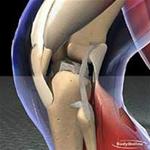Dislocation is a condition characterized by the loss of normal anatomical relationships between joint surfaces following a strong trauma to the joint or limb. It can also occur due to congenital factors or underlying diseases.
Signs of Dislocation:
–
 |
| Anatomical image of the knee joint (Photo: TTO) |
Pain due to damage or tearing of the joint capsule.
– Reduced or completely lost joint function.
– The joint cavity may appear empty, which is a specific sign of dislocation. However, not all joints exhibit this symptom; it is typically found in the shoulder joint, jaw joint, and partially in the elbow joint. If a patient seeks treatment late, this sign may be difficult to notice due to significant swelling in the painful area.
– Total limb deformity: If there is a shoulder dislocation, the arm will always be deformed and cannot be brought close to the body. In the case of hip dislocation, the limb appears shortened, the knee turns inward, and the foot on the affected side rests on the healthy ankle.
– An abnormal prominence due to the head of the bone being displaced out of the joint cavity.
– Elastic movement, also known as the spring sign, occurs only in dislocations where the head of the bone is displaced and tightly bound within the muscle, tendon, and ligament mass. Even when attempts are made to pull or push the joint back to its normal position, it still snaps back into the dislocated position.
In addition to the typical signs mentioned above, dislocations may also present with specific deformity signs such as: the shoulder hunch sign (a right angle shoulder) commonly seen in shoulder dislocations; the axe cut sign observed in cases of posterior elbow dislocation (where the elbow protrudes backward, creating an inward dimple like a tree stump being axed); and the piano key sign seen in acromioclavicular joint dislocations.
Management
In many cases of dislocation, patients often attempt to pull the joint back into place themselves, usually with the help of others who lack expertise. This can exacerbate pain and complicate the treatment process.
If you experience a dislocation during work or daily activities, it is essential to seek a proper diagnosis and imaging from a joint specialist. In many instances, trauma may not only lead to dislocation but also result in ligament sprains, strains, fractures, or broken bones.
For elderly individuals, extra caution is advised. If not treated promptly, dislocations can lead to complications such as blood vessel or nerve compression, open dislocations accompanied by bone fractures, and more.


















































